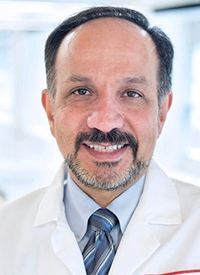DLL3-Directed BiTE, AMG 757 Shows Early Tolerability and Efficacy in Small Cell Lung Cancer
November 12, 2020 - AMG 757, a DLL3-directed, half-life extended bispecific T-cell engager, was shown to have a feasible adverse effect profile in patients with small cell lung cancer.
Hossein Borghaei, DO, MS

November 12, 2020 - AMG 757, a DLL3-directed, half-life extended bispecific T-cell engager (BiTE), was shown to have a feasible adverse effect (AE) profile in patients with small cell lung cancer (SCLC), according to interim results from a phase 1 clinical trial (NCT03319940) that were presented ahead of the 2020 SITC Virtual Congress.
Any-grade treatment-related AEs (TRAEs) were observed in 80% of the 40 patients treated. Grade 3 or higher TRAEs occurred in 18% of patients.
The most common TRAEs that occurred in 10% or more of patients included cytokine release syndrome (CRS; n = 17; 43%), pyrexia (n = 7; 18%), fatigue (n = 6; 15%), nausea (n = 5; 13%), and anemia (n = 5; 13%).
One case of grade 3 or higher anemia was reported. Additionally, one patient experienced grade 5 pneumonitis with AMG 757.
“As far as tolerability is concerned, none of the patients with CRS required vasopressors, high oxygen requirements, or hospitalization,” said lead study author Hossein Borghaei, DO, MS, chief of the Division of Thoracic Medical Oncology at Fox Chase Cancer Center. “Nonetheless, it is something that we have recorded.”
BiTE molecules utilize a patient’s T cells to attack and effectively eradicate cancer cells, said Borghaei. AMG 757 engages endogenous T cells and SCLC cells to induce T-cell proliferation and serial lysis followed by apoptosis of tumor cells.
“[AMG 757] is a half-life extended molecule that creates an immunologic synapse, if you will, between the tumor cell that is expressing DLL3 as its antigen, as is commonly expressed in SCLC, and CD3 expressed on T cells,” explained Borghaei, who is also a professor within the Department of Hematology/Oncology, co-director of the Immune Monitoring Facility, and the Gloria and Edmund M. Dunn Chair in Thoracic Oncology. “The idea here is to bring the immune activation right to the site of the tumor microenvironment, leading to an immunologic effect [and] to cancer cell death.”
The first-in-human, dose-exploration trial enrolled patients with relapsed/refractory SCLC. The primary objectives of the study were to evaluate the safety and tolerability of AMG 757 in SCLC and to determine the maximum-tolerated dose or recommended phase 2 dose of the agent. Secondary objectives included pharmacokinetic characterization and evaluation of preliminary antitumor activity.
Additionally, an exploratory objective was to evaluate immunogenicity, biomarkers, and target protein and outcomes with AMG 757.
One to 4 patients were included in each dose cohort. The open-label, multicenter study evaluated a target dose of 0.003 mg to 10.0 mg of AMG 757, which was administered intravenously every 2 weeks with and without step dosing. Step dosing was utilized to mitigate cytokine storm.
To date, patients in the dose-exploration cohort have undergone mandated hospitalization for 48 to 72 hours of in-house monitoring, said Borghaei.
During disease assessment, antitumor activity was assessed using modified RECIST 1.1 criteria.
The median patient age was 64 years (range, 44-80). The majority of patients (68%) were former smokers, and 15% were current smokers. Nearly all patients (98%) had an ECOG performance status of 0 or 1.
Additionally, 70% of patients had received 1 or 2 prior lines of therapy and the remaining patients had received 3 or more. The median number of prior lines of therapy was 2 (range, 1-6). Forty-three percent of patients had prior exposure to PD-1/PD-L1 treatment.
Nearly all patients (98%) had extensive-stage SCLC. Additionally, 30% had treated, stable brain metastases at baseline and 45% had liver metastases, Borghaei explained.
Regarding preliminary efficacy, the partial response (PR) rate was 16%, said Borghaei.
“An additional 15% of patients have achieved stable disease,” Borghaei continued. “A lot of these [responses] are still early and confirmatory CT [scans] are pending.”
A 66-year old woman who had achieved a PR by the first follow-up scan had received 6 prior lines of treatment, including cisplatin plus etoposide, topotecan, gemcitabine plus irinotecan, cyclophosphamide plus doxorubicin and vincristine, paclitaxel, and lurbinectedin (Zepzelca). She received the 10 mg dose of AMG 757 with step dosing during cycle 1. Overall, the patient received 3 complete cycles of treatment and continued to receive treatment at the time of the data cutoff.
At 2.9 months of follow-up, the patient derived a 66.7% decrease in tumor size within the left upper lung lobe vs baseline and a 51.3% decrease in tumor size within the right upper lung lobe vs baseline. Additionally, the patient had a 45.7% decrease in a metastatic lesion in the liver, which was located at T04 in liver segment II, vs baseline and a 41.8% decrease in a metastatic lesion in the liver, located at T05 in liver segment VI.
“For a patient population with a diagnosis of metastatic [SCLC who received] multiple prior treatments, having compounds with reasonable tolerability and clinical activity is an area of need. We are continuing to enroll patients at other dose levels,” Borghaei said.
Further evaluation is needed to determine whether CRS was correlated with factors such as DLL3 antigen density on the tumors. Additionally, Borghaei is hopeful that these data will lend insight into biomarker development for patients with SCLC.
“With the exception of the recently published gene expression data, which divides SCLC into 4 categories, we haven’t been able to develop meaningful biomarkers. However, that work is ongoing,” concluded Borghaei.
Reference
Borghaei H, Boyer M, Johnson M, et al. AMG 757, a half-life extended bispecific T-cell engager (BiTE®) immune therapy against DLL3 in SCLC: phase 1 interim results. Presented at: SITC Virtual Congress; November 9-14, 2020. Abstract: 359



